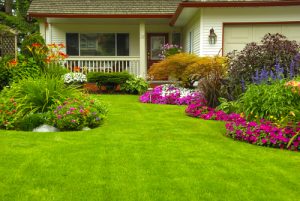Landscaping With Pests in Mind – Advice From the Pros
By Chris Williams on March 12, 2012.
Did you know that the landscaping around your home could be a factor in whether pests end up inside your home? Now that spring is in the air and folks are starting to plant and mulch, plan your landscaping and plant selections to reduce pests around your home at the same time that you beautify your surroundings.
 The following guidelines can help reduce the number of insects around the perimeter of your home, and consequently the number that could end up inside. These guidelines were originally designed for food plants and warehouses that must adhere to strict government regulations regarding food purity and cannot afford to have a single pest inside. They are useful for homeowners to consider as well. While no one should be expected to follow all of these guidelines in their yard, you might choose to implement the ones that are most pertinent to your situation and the easiest to undertake.
The following guidelines can help reduce the number of insects around the perimeter of your home, and consequently the number that could end up inside. These guidelines were originally designed for food plants and warehouses that must adhere to strict government regulations regarding food purity and cannot afford to have a single pest inside. They are useful for homeowners to consider as well. While no one should be expected to follow all of these guidelines in their yard, you might choose to implement the ones that are most pertinent to your situation and the easiest to undertake.
- No plants or organic mulch (wood, straw, pine needles, grass clippings) within 2 to 3 feet of the foundation. Leave open ground or substitute a border strip of crushed stone or pebbles with landscaping fabric underneath.
- Don’t apply mulch deeper than a couple of inches. Mulch that is too deep stays wet too long. Damp, moldy wood invites moisture-loving pests like sowbugs, earwigs, millipedes, and springtails.
- No thick ground covers or dense low shrubbery – These hide rodents and their burrows.
- No fruit or berry bushes near the house – Ripe and rotting fruit attracts rodents, fruit flies, yellowjackets, and other pests.
- No nut trees – Fallen nuts attract rodents.
- No boxelder, elm, or zelkova trees – Boxelder bugs feed on the female boxelder tree. Elm leaf beetles feed on elm and zelkova. Both of these pests enter nearby buildings in the fall to overwinter. Other ornamental plants can be host to certain pests as well. Check with a horticulturist or nursery for pest-free recommendations.
- No flowering plants directly around the foundation – Flowering plants attract nectar and pollen-feeding insects, wasps, and bees. Avoid spirea, crape myrtle, pyracantha, ceanothus, and dogwood, which are all favorites of dermestid (carpet) beetles that can move inside.
- No tree branches closer than 4 feet to the house – Rats and squirrels can jump onto roofs from nearby trees, and ants and other trailing pests will use branches touching the house as pathways to get inside.
- Don’t allow ivy or vines to grow up the walls of the house – Rodents and sparrows will nest in the foliage.
- Avoid mound-shaped, ground-hugging shrubs – These shrubs hide rodents and their burrows. Wine glass-shape plants and others open at the base are a better choice.
- Avoid dense groupings of plants or shrubs – These hide pests and trap trash.
This doesn’t mean the area around your house has to be a wasteland. Just choose plants wisely, keep them trimmed, and keep plants away from the house itself. Plant-feeding insects tend to infest plants that are sickly or under stress from drought so keeping plants healthy and pest-free also reduces the chance of pest invasion from outside.